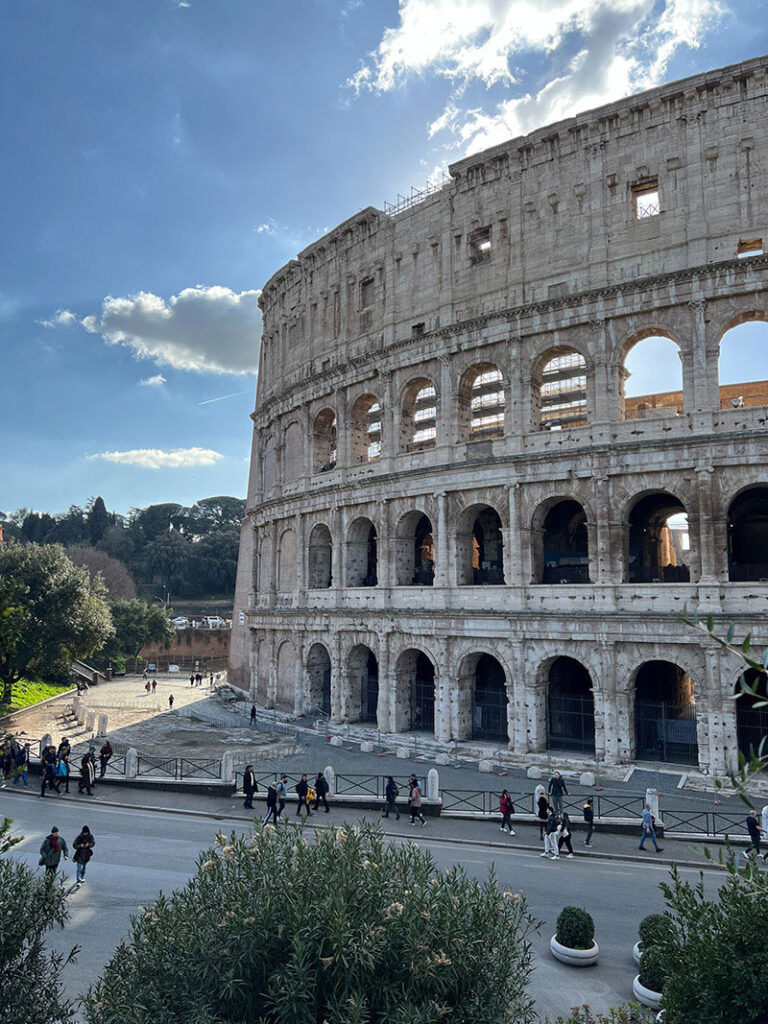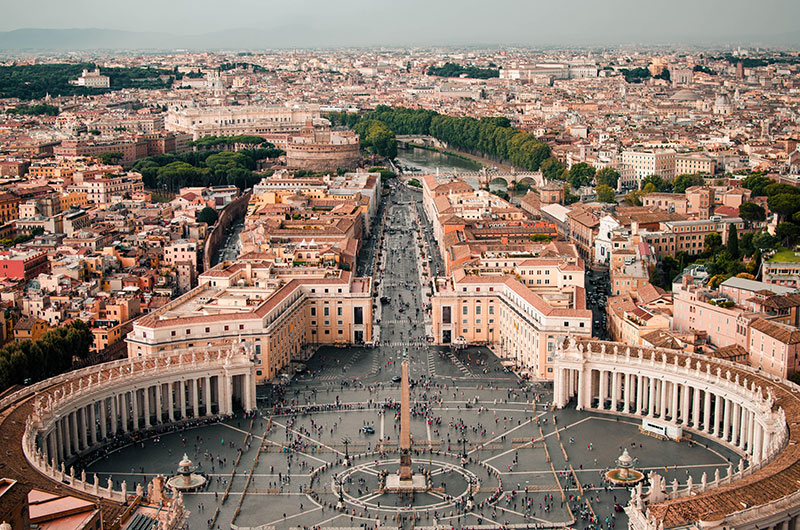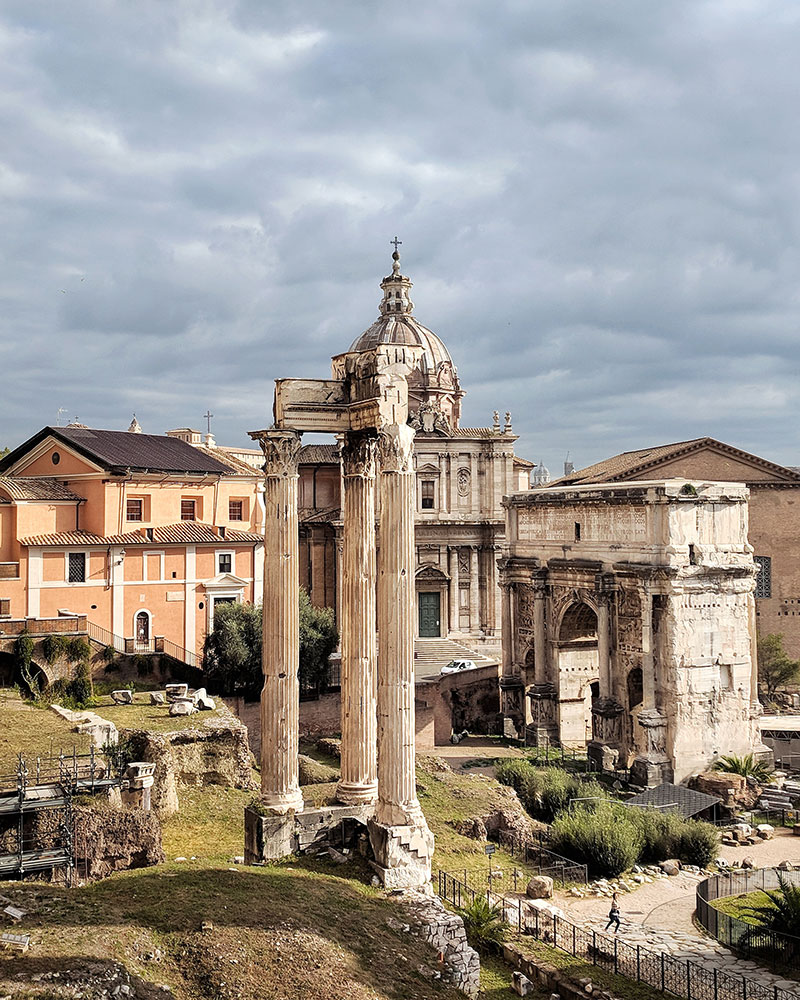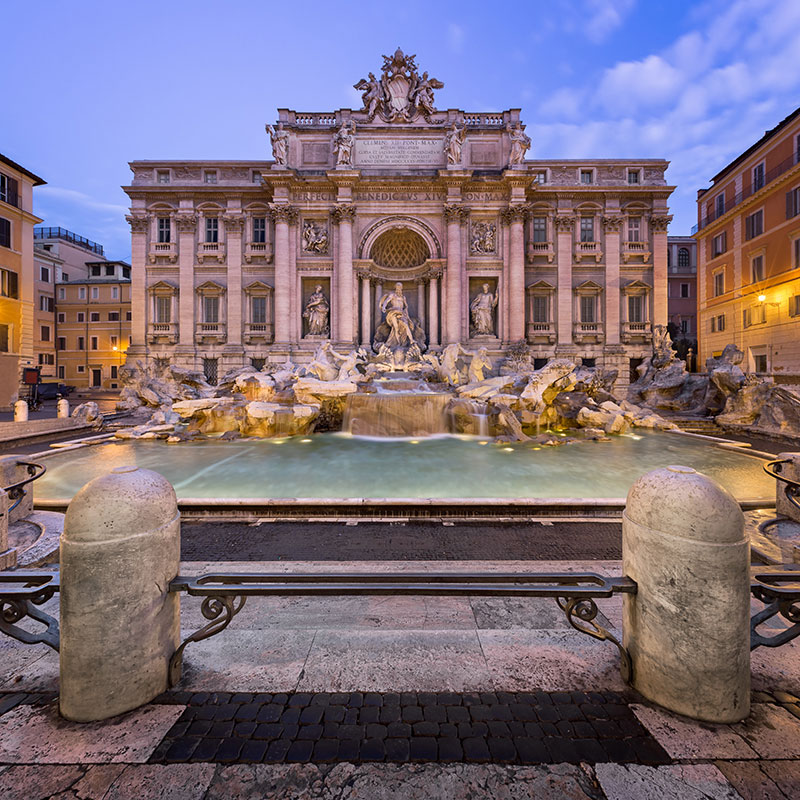Introduction
Settled along the banks of the Tiber River, Rome stands as a living testament to its glorious past. The Eternal City, with its rich history spanning over two millennia, offers an unparalleled blend of ancient wonders and modern delights.
As you stroll through the cobblestone streets, Rome’s iconic landmarks and breathtaking architectural marvels transport you back in time. In this article, you will discover the most visited tourist attractions in Rome, inviting you to embark on an unforgettable journey through the heart of Italy’s capital.
Colosseum

Situated to the East of the Roman Forum, the colossal stone amphitheater famously called the Colosseum was commissioned by Emperor Vespasian of the Flavian dynasty as a generous offering to the Roman people in the years A.D. 70-72. In A.D. 80, the Flavian Amphitheater, commonly called the Colosseum, was inaugurated by Vespasian’s son, Titus, who celebrated the occasion with an extravagant celebration. This grand event featured thrilling gladiatorial contests and spectacles of ferocious animal clashes.
Over the course of four centuries, the majestic arena witnessed constant activity, but eventually succumbed to neglect, gradually losing its former glory. By the 18th century, it had fallen into disrepair and was even utilized as a source of construction materials. Despite enduring the ravages of time, with approximately two-thirds of its original structure destroyed, the Colosseum kept its prestige as the most popular attraction in the city. It not only serves as a testament to Rome’s enduring legacy but also symbolizes its tumultuous and eventful history.
A symbol of Rome’s grandeur and power, the Colosseum tops the must-visit list for any traveler. This colossal amphitheater, constructed in AD 70-80, could accommodate over 50,000 spectators who gathered to witness thrilling gladiatorial contests and other spectacles.
As you stand in front of its towering facade, imagine the roars of the crowd echoing through its arches. Inside, explore the labyrinthine passageways and marvel at the engineering prowess of ancient Rome. Don’t miss the underground chambers where gladiators and animals awaited their turn in the arena. A visit to the Colosseum is a remarkable journey into the city’s past.
Vatican City

The world’s smallest independent state, the Vatican City, lies within the heart of Rome. This spiritual and cultural center encompasses St. Peter’s Basilica, the Sistine Chapel, and the Vatican Museums. Step inside St. Peter’s Basilica, the largest church on Earth, and admire Michelangelo’s iconic Pietà sculpture.
Ascend to the dome for panoramic views of Rome’s rooftops. Next, enter the Vatican Museums, home to an astonishing collection of art, including Raphael’s frescoes in the Raphael Rooms. Conclude your visit with a reverent silence in the Sistine Chapel, where Michelangelo’s ceiling frescoes, notably “The Creation of Adam,” inspire awe.
Embracing Christianity after the Edict of Milan in 313, Emperor Constantine I embarked on the construction of a basilica atop St. Peter’s tomb in 324. This grand endeavor gave rise to St. Peter’s Basilica, which evolved into a significant spiritual hub for Christian pilgrims.
The presence of these devout visitors led to the development of housing for clergymen and the emergence of a bustling marketplace that eventually transformed into the thriving commercial district of Borgo.
In 846, St. Peter’s Basilica suffered damage from an assault by Saracen pirates. In response, Pope Leo IV ordered the construction of a protective wall around the revered basilica and its surroundings.
Completed in 852, this formidable 39-foot-tall wall enclosed an area known as the Leonine City, which encompassed the present-day Vatican territory and the Borgo district. The walls continued expansion and modification until the reign of Pope Urban VIII in the 1640s.
Traditionally, the pope resided at the nearby Lateran Palace. However, in the early 6th century, Pope Symmachus constructed a residence adjacent to St. Peter’s. Centuries later, Eugene III and Innocent III expanded this residence, and in 1277, a covered passageway spanning half a mile was built to connect it to Castel Sant’Angelo.
Nevertheless, these buildings were abandoned when the papal court relocated to Avignon, France, in 1309, and over the following decades, the city fell into disrepair.
After the Catholic Church’s return in 1377, the clergy endeavored to restore the splendor of the walled city. Around 1450, Nicholas V initiated the construction of the Apostolic Palace, which would eventually become the permanent residence of his successors.
His collection of books formed the foundation of the Vatican Library. In the 1470s, Sixtus IV ordered the construction of the renowned Sistine Chapel, adorned with breathtaking frescoes by leading Renaissance artists such as Botticelli and Perugino.
Significant changes occurred in the city when Julius II ascended to the papal office in 1503. Julius commissioned Michelangelo to paint the ceiling of the Sistine Chapel in 1508 and enlisted architect Donato Bramante to design the Belvedere Courtyard. The pontiff also decided to demolish the 1,200-year-old St. Peter’s Basilica and replace it with a new one, to be built by Bramante.
The death of Julius in 1513 and Bramante the following year led to a protracted dispute over how to proceed with the project. The deadlock finally ended in 1547 when Michelangelo chose to follow Bramante’s original design.
Giacomo della Porta completed the celebrated dome of St. Peter’s in 1590, and the grand structure was finally finished in 1626. Standing at a height of 452 feet and covering 5.7 acres, the new St. Peter’s became the world’s largest church, a title it held until the completion of the Basilica of Our Lady of Peace of Yamoussoukro in Ivory Coast in 1989.
The Vatican Museums originated from Julius II’s sculpture collection, and its earliest gallery was opened to the public by Pope Clement XIV in 1773. Subsequent popes continued to expand the renowned collections over the years, including the addition of the Gregorian Egyptian Museum, the Ethnological Museum, and the Collection of Modern and Contemporary Religious Art.
Until 1870, the popes held power over the Papal States, regional territories. However, the unified Italian government claimed most of the land outside the city walls. A standoff between the church and the secular government persisted for the next 60 years, until 1929.
Benito Mussolini ended a dispute between the Italian government and Holly See (Pope ) by signing a Lateral Treaty. According to this agreement, Pop’s jurisdiction under Vatican City is fully recognized and confirmed again in the Italian Constitution (1948)
The Roman Forum

A stone’s throw from the Colosseum lies the Roman Forum, once the political and commercial hub of ancient Rome. As you wander through the ruins, the echoes of history surround you.
Imagine senators deliberating, citizens gathering, and triumphal processions parading through these storied streets. Stand in the middle of the ruins of the Temple of Saturn, the Arch of Titus, and the House of the Vestals, absorbing the grandeur of the past. The Roman Forum offers a glimpse into the daily life of ancient Romans and the evolution of their civilization.
Originally, the Roman Forum primarily served as a marketplace where people engaged in daily shopping activities. However, as time passed, its significance grew, and it evolved into a multifunctional space where public affairs were conducted.
Around 500 B.C., during the establishment of the Roman Republic, the Forum witnessed the emergence of public events and gatherings. This marked the beginning of its transformation and gradual expansion over the centuries. Various structures such as statues, arches, and basilicas were erected to accommodate the growing needs of the assemblies held there.
During the reign of Julius Caesar, the Forum became increasingly overcrowded. To solve this issue, Caesar took the initiative to build a new forum adjacent to the original one, providing additional space for the city’s activities. Later, during the reign of Emperor Augustus, further expansions and enhancements were made to the Forum, solidifying its significance as a central hub of Roman public life.
The Roman Forum housed numerous significant structures, statues, and monuments, many of which were dedicated to deities or revered individuals. Some notable buildings in the Roman Forum included:
The Senate House: Referred to as the “Curia,” the senate house served as the meeting place for the Roman Senate and hosted various political gatherings. It underwent several reconstructions throughout its history and was transformed into a church in the 7th century.
Temple of Saturn: The original Temple of Saturn was erected around 498 B.C., making it one of the oldest temples in the Roman Forum. However, it was reconstructed in later years, and the existing ruins date back to approximately 42 B.C. This temple honored Saturn, the god of agriculture, and functioned as a treasury where Rome’s finances were managed and stored.
Arch of Titus: Constructed in 81 A.D. by Emperor Domitian, the Arch of Titus commemorated his victorious brother, Emperor Titus, who led the Siege of Jerusalem.
Temple of Vesta: Dedicated to Vesta, the goddess of hearth, home, and family, the Temple of Vesta boasted a distinctive circular design.
Today, the Roman Forum stands as a highly popular tourist destination, attracting visitors from around the world. Exploring the ancient ruins and architectural fragments provides a firsthand experience of their historical significance. There are ongoing efforts to restore and preserve these ruins, highlighting their importance as a cultural heritage
The Rostra: Serving as a platform for delivering speeches, the Rostra provided individuals with a prominent space to address the public.
Temple of Castor and Pollux: Believed to have been completed around 484 B.C., this temple paid homage to the twin demigods of Roman mythology, Castor and Pollux. It underwent several phases of construction.
The Sacra Via: Serving as the main road that traversed the Roman Forum, the Sacra Via connected various significant sites. This renowned street also extended to the Colosseum, which was conveniently situated within walking distance from the Forum. The Sacra Via primarily served as a ceremonial pathway and a route for processions.
These remarkable structures and thoroughfares formed an integral part of the Roman Forum, reflecting the rich historical and cultural heritage of ancient Rome.
The Pantheon

Marvel at the architectural genius of the Pantheon, a testament to Roman engineering. This nearly 2,000-year-old temple, dedicated to the gods of ancient Rome, features a massive domed roof with a central oculus, allowing a beam of natural light to illuminate the interior. Stand beneath the dome, gazing up at the heavens, and feel the weight of history surrounding you. The Pantheon’s harmonious proportions and stunning interior decoration make it a must-visit attraction.
For over two thousand years, the Pantheon has stood as a magnificent testament to the grandeur of Rome. Its story is intricately intertwined with the history of the Eternal City and has served as its enduring symbol throughout the ages.
Originally constructed by Agrippa between 25 and 27 BC, the Pantheon was built as a temple dedicated to the twelve Gods and the reigning sovereign. However, it is widely believed that the existing structure is the result of a significant reconstruction carried out by emperor Hadrian between 118 and 125 AD. Remarkably, the Pantheon remains one of the few ancient Roman buildings that has managed to retain its original form over the centuries, virtually intact.
In 608, Pope Boniface IV made a historical decision to repurpose the temple. He had the remains of numerous Christian martyrs transferred from the catacombs and interred within the Pantheon. Subsequently, the temple was officially converted into a Christian church and named Santa Maria ad Martyres. This transformation solidified its significance as a sacred place within the Christian faith.
Trevi Fountain

No visit to Rome is complete without tossing a coin into the Trevi Fountain. This magnificent Baroque masterpiece, sculpted from travertine stone, depicts Neptune, the god of the sea, surrounded by mythical sea creatures. Legend has it that throwing a coin into the fountain ensures your return to Rome. Join the crowd and make your wish as the water cascades down, creating an incredible spectacle.
Designed by Nicola Salvi and completed by Giuseppe Pannini in 1762, the Trevi Fountain in Rome holds a place of enchantment and legend. It is believed that tossing a coin into its waters ensures a return to the eternal city.
Situated in Rome’s Trevi district, adjacent to the Palazzo Poli, the current fountain replaced an earlier one that was demolished in the 17th century. In 1732, Nicola Salvi emerged as the winner of a design competition for a new fountain. His creation became a marvel of scenic beauty.
The fountain’s centerpiece, a majestic triumphal arch adorned with mythological and allegorical figures, natural rock formations, and cascading water, was the genius of Salvi. The construction of the Trevi Fountain lasted approximately 30 years, with Giuseppe Pannini taking charge after Salvi’s passing in 1751. Pannini made slight modifications to the original design and oversaw its completion in 1762.
The Trevi Fountain draws your attention with its imposing stature, standing at around 85 feet (26 meters) in height and stretching approximately 160 feet (49 meters) in width. At its heart is the statue of Oceanus, created by Pietro Bracci.
Oceanus stands atop a chariot drawn by sea horses and is accompanied by tritons. The fountain also features statues depicting Abundance and Health.
The water flowing through the fountain originates from the ancient Acqua Vergine aqueduct and was renowned for its softness and excellent taste, making it Rome’s preferred drinking water. Barrels of this water were transported weekly to the Vatican for centuries. However, the water is now non-potable.
The Trevi Fountain remains a cherished symbol of Rome’s beauty and allure, captivating visitors with its grandeur and timeless glamour.
Conclusion
In this article, we presented to you the top 5 most visited places and destinations in Rome. The eternal city has indeed a fascinating past and great cultural heritage. Rome is a city where ghosts of the past are still dwelling in the ancient streets and the present is colliding with the past creating a unique ambiance and experience you won’t be able to forget. If you have willingness and time check out other attractive destinations in Europe, Read More






